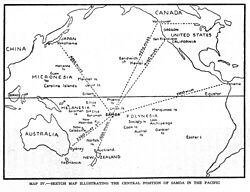 This article details the history of Samoa. The Independent State of
Samoa, formerly known as Western Samoa, is a country encompassing the western
part of the Samoan Islands in the South Pacific Ocean. It became independent
from New Zealand in 1962.
This article details the history of Samoa. The Independent State of
Samoa, formerly known as Western Samoa, is a country encompassing the western
part of the Samoan Islands in the South Pacific Ocean. It became independent
from New Zealand in 1962.Samoa is recognized as the center of Polynesia, from where people migrated eastward to the Marquesas, southward to Niue and the Pukapuka islands of Rarotonga, and northward to the Tokelau and Tuvalu island groups; in all these islands, oral tradition is maintained of ancestral voyages from the Samoan islands. These migrations reflect the extraordinary courage of these seafaring people in navigating without instruments to sail throughout the vast Pacific Ocean.
Samoa before the arrival of Europeans;
Archeologists place the earliest human settlement
of the Samoan archipelago at around 1500 B.C. This
date is based upon the ancient lapita pottery shards found throughout the
islands. Samoan oral history, however, extends only as far back as 1000 A.D.
Whatever occurred between 1500 B.C. and 1000 A.D. remains a mystery, though this
may have been the period of great migrations that led to the settlement of
present-day Polynesia. Another
mystery is that the making of pottery suddenly stopped; there is no oral
tradition among the people of Samoa that explains this.
Linguistically, the Samoan language is part of the Austronesian language family. It
is related to the Tagalog language of the Philippines as well as the languages
spoken by the indigenous people of Taiwan and Sri Lanka.
Prior to the arrival of the Europeans in the early 1700s, Samoa's history was interwoven with that of certain chiefdoms of Fiji as well as the history of the kingdom of Tonga. The oral history of Samoa preserves the memories of many battles fought between Samoa and neighboring islands. Too, intermarriage of Tongan and Fijian royalty to noble Samoan women has helped build close relationships between these island nations that exists even to the present day; these royal blood ties are acknowledged at special events and cultural gatherings. Samoan folklore tells of the arrival of two maidens from Fiji who brought the art of tatau, or tattoo, to Samoa, whence came the traditional Samoan malofie (malofie is also known as pe'a for men and as malu for women).
Bestowal of the highly reverential title "Malietoa" marked a period in Samoan history. The title refers to the parting words of Tongan warriors, "Malie toa, malie tau" (literally, "Brave warrior, bravely fought"). Hence, the title was amended as part of the more ancient royal courts and titles of Tui A'ana, Tui Atua.
These tales reflect Samoa's colorful and at times fierce past.
Prior to the arrival of the Europeans in the early 1700s, Samoa's history was interwoven with that of certain chiefdoms of Fiji as well as the history of the kingdom of Tonga. The oral history of Samoa preserves the memories of many battles fought between Samoa and neighboring islands. Too, intermarriage of Tongan and Fijian royalty to noble Samoan women has helped build close relationships between these island nations that exists even to the present day; these royal blood ties are acknowledged at special events and cultural gatherings. Samoan folklore tells of the arrival of two maidens from Fiji who brought the art of tatau, or tattoo, to Samoa, whence came the traditional Samoan malofie (malofie is also known as pe'a for men and as malu for women).
Bestowal of the highly reverential title "Malietoa" marked a period in Samoan history. The title refers to the parting words of Tongan warriors, "Malie toa, malie tau" (literally, "Brave warrior, bravely fought"). Hence, the title was amended as part of the more ancient royal courts and titles of Tui A'ana, Tui Atua.
These tales reflect Samoa's colorful and at times fierce past.
